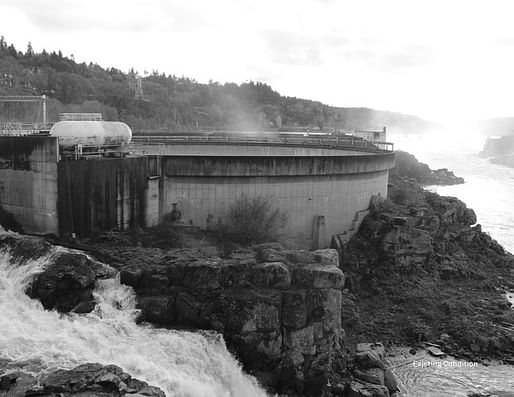
Oregon state, home to some of the nation’s most spectacular gorges and naturally occurring waterfalls, will soon uncover what might become its most compelling ecological landmark. Willamette Falls, of Oregon’s Willamette River, is the United States’ second largest waterfall by volume, and has been blocked from public access for well over a century.
International design firm Snøhetta has been selected to redevelop the 22-acre former industrial site located at the entrance of Oregon City into a public riverwalk. Boasting 60 species of fish, a host of unique flora and fauna and historic basalt topography, the site necessitates a sensitive restoration protocol for the firm, who is working with Portland’s Mayer / Reed and Vancouver’s DIALOG to carry out the project.

“The riverwalk will serve as a portal to the Northwest’s collective history,” announced the firm in a press release, “reviving a former industrial site through its aggregated layers of natural, ecological, cultural, and geological history.” Working across 4 key sites in the former wool factory, Snøhetta plans to rehabilitate a series of existing buildings into a network of public engagement programs and viewpoints.
“Beginning at the entrance to Oregon City’s historic downtown and ending at the crest of the falls themselves, the riverwalk is conceived as sequence of islands, an archipelago carved from ancient basalt and industrial steel, concrete, and wood alike,” states the firm.


The proposal illustrates plans for the “Public Yard,” an open plaza nestled within two perpendicular buildings of the former Woolen Mill, which shifts levels over the sloping topography with a series of stairways meant for sitting and traversing the site. The Yard will connect with landscaped paths leading to the river’s edge.
Adjacent to the Yard, Snøhetta has proposed converting another mill into a public visitor center, which will also feature a multi-functional stairwell, intended as a kind of indoor/outdoor theater for public events.

In addition to these programmable sites, the proposal outlines the development of a series of panoramic viewpoints and public promenade affording full visibility of the falls and the PGE Dam.
“Through sensitive site editing, the design will provide public access and interpretation of a unique crop of nationally important historic structures that charted the industrial history of the Pacific Northwest.”
Construction of the landmark project is projected to begin in 2018.
3 Comments
As you are discussing this project with your peer architecturalati be aware that it's pronounced "Wil-LAM-ett" not wil-a-MET.
It is a gorgeous natural falls too that has been an industrial ruin for a long time. Very excited for this project.
Also, everyone should read Geek Love.
Thanks Donna, we Portlanders love our unique pronunciations (Can you show me the way to Couch St?)
It was fun to provide feedback last November on the design options for this massive project. I'm glad the community has been involved - I'm a big fan of Macadam Ave ;)
Block this user
Are you sure you want to block this user and hide all related comments throughout the site?
Archinect
This is your first comment on Archinect. Your comment will be visible once approved.